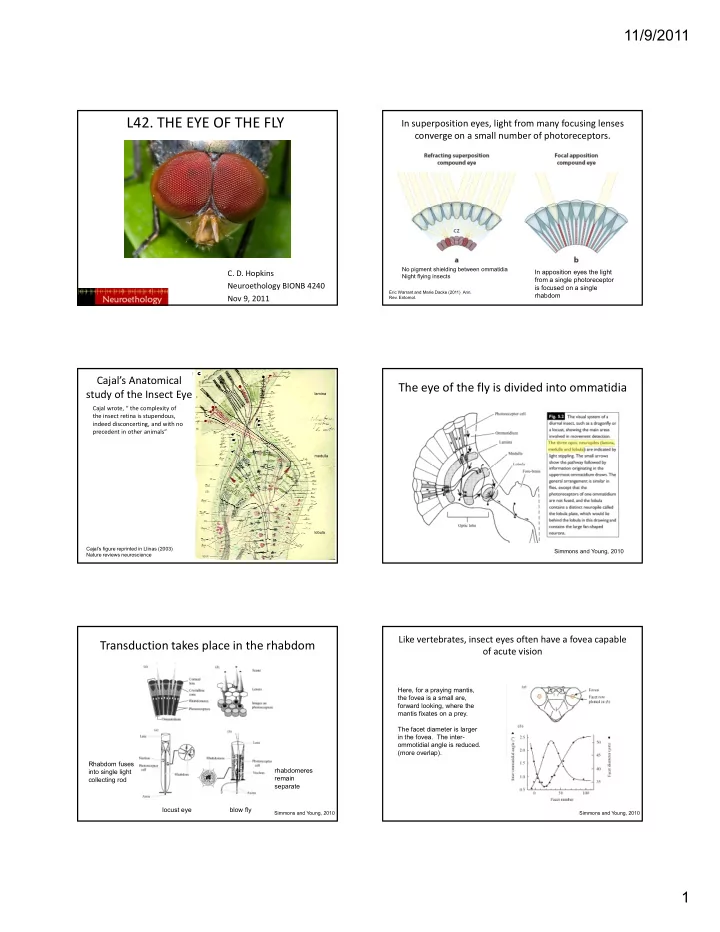

11/9/2011 L42. THE EYE OF THE FLY In superposition eyes, light from many focusing lenses converge on a small number of photoreceptors. No pigment shielding between ommatidia In apposition eyes the light C. D. Hopkins Night flying insects from a single photoreceptor Neuroethology BIONB 4240 is focused on a single Eric Warrant and Marie Dacke (2011) Ann. rhabdom Nov 9, 2011 Rev. Entomol. Cajal’s Anatomical The eye of the fly is divided into ommatidia study of the Insect Eye lamina Cajal wrote, “ the complexity of the insect retina is stupendous, indeed disconcerting, and with no precedent in other animals” medulla lobula Cajal’s figure reprinted in Llinas (2003) Simmons and Young, 2010 Nature reviews neuroscience Like vertebrates, insect eyes often have a fovea capable Transduction takes place in the rhabdom of acute vision Here, for a praying mantis, the fovea is a small are, forward looking, where the mantis fixates on a prey. The facet diameter is larger in the fovea. The inter- ommotidial angle is reduced. (more overlap). Rhabdom fuses rhabdomeres into single light remain collecting rod separate locust eye blow fly Simmons and Young, 2010 Simmons and Young, 2010 1
11/9/2011 The speed of the eye varies with the flight The fovea varies according to the visual behavior of the insect patterns of two flies Tipula: crane fly, is For four species, contour plots of numbers nocturnal, of ommatidia per unit solid angle. slow flying. b) Caliphora (blowfly) Fleshflies are diurnal, c) Apis male (honeybee) fast moving d) Annax junius (dragonfly) e) Gerris (waterstrider) 0.5 s Land, M. (1997) Visual accuity in insects. Annu. Rev. Entomol. 1997. 42:147–77 Simmons and Young, 2010 The lamina neurons enhance the transient (flicker) The lamina and a lamina monopolar cell responses by removing background light levels the photoreceptor responds with depolarizing potential (overshoot, then relax to plateau) axon responds axon responds with depolarizing potentail. The LMC neuron is inhibited by the photoreceptor. and is more “phasic”. DC response is eliminated, edges enhanced. (hi- pass). S. Laughlin From Laughlin, S. (in Shepherd and Grilner: handbook of Simmons and Young, 2010 brain microcircuits, 2010) The fly lamina enhances the high frequency component of the amplitude modulated light Werner Bernhard Reichardt Hassenstein From Laughlin, S. (in Shepherd and Grilner: handbook of brain microcircuits, 2010) 2
11/9/2011 Early Experiments Y-Maze The Reichardt (Correlation) Glossary Motion Detector • Luminance 2 1 • Contrast Photoreceptors • Temporal frequency =velocity/wavelength Low-pass filters F F 2 create delay 1 ( (variation that a single g A receptor sees) A 1 2 Multiplier Subtractor = R(t) A (T)F (T - t) - A (T)F (T - t) 2 1 1 2 Lobula Plate Tangential Cells (LPTC) in the lobula plate of the blow fly, Calliphora , Delay line coincidence detector produces motion response in H1 respond to motion in the horizontal plane (HS neurons) (a) or vertical plane (VS neurons (elementary motion detector) neurons) anywhere in the visual field of the eye. ccw downward HS VS Nicholas Franceschini CNRS, Marseille France H1 neurons allow left right comparisons (distinguish rotation from forward visual flow) sequential activation of just two photoreceptors within a single ommatidium evoke responses from H1 only in the preferred direction. (From Franceschini et al, 1989) Franceschini et al, 1989 (from Simons and Young, 2010) 3
11/9/2011 Motion sensing neurons in Lobula Plate Reichardt Motion Detector Model Possible connectivity Borst & Euler Neuron 71, September 22, 2011 References Hassenstein, B. & Reichardt, W. Z. Naturforsch. 11b, 513–524 (1956). Reichardt, W. in Sensory Communication (ed. Rosenblith, W. A.) 303–317 (MIT Press, Cambridge, Massachusetts, 1961). Borst, A. & Egelhaaf, M. Trends Neurosci. 12, 297–306 (1989). van Santen, J. P. H. & Sperling, G. J. Opt. Soc. Am. A 2, 300–320 (1985). Adelson, E. H. & Bergen, J. R. J. Opt. Soc. Am. A 2, 284–299 (1985). Barlow, H. B. & Levick, W. R. J. Physiol. (Lond.) 178, 477–504 (1965). Koch C Poggio T & Torre V Proc Natl Acad Sci USA 80, 2799–2802 (1983). Koch, C., Poggio, T. & Torre, V. Proc. Natl. Acad. Sci.USA 80, 2799 2802 (1983). Borst, A. (2000) Models of motion detection. Nature neuroscience supplement 3:1168. Borst, A. and Euler, T. (2011) Seeing things in motion: models, circuits, and mechanisms. Neuron 71, 974 ‐ 94. Egelhaaf, M. and Borst, A. (1993). Motion computation and visual orientation in flies. Comp Biochem Physiol Comp Physiol 104, 659 ‐ 73. Franceschini, N. Riehle, A. and Le Nestour, A. (19889) Directionally selective motion detection by insect neurons. In Facets of Vision (ed. D. G. Stavenga and R. C. Hardie) pp 360 ‐ 390. Berlin. Springer. Warrant, E. and Dacke, M. Vision and visual navigation in nocturnal insects. Annu Rev Entomol 56, 239 ‐ 54. Egelhaaf and Borst (1993) 4
Recommend
More recommend